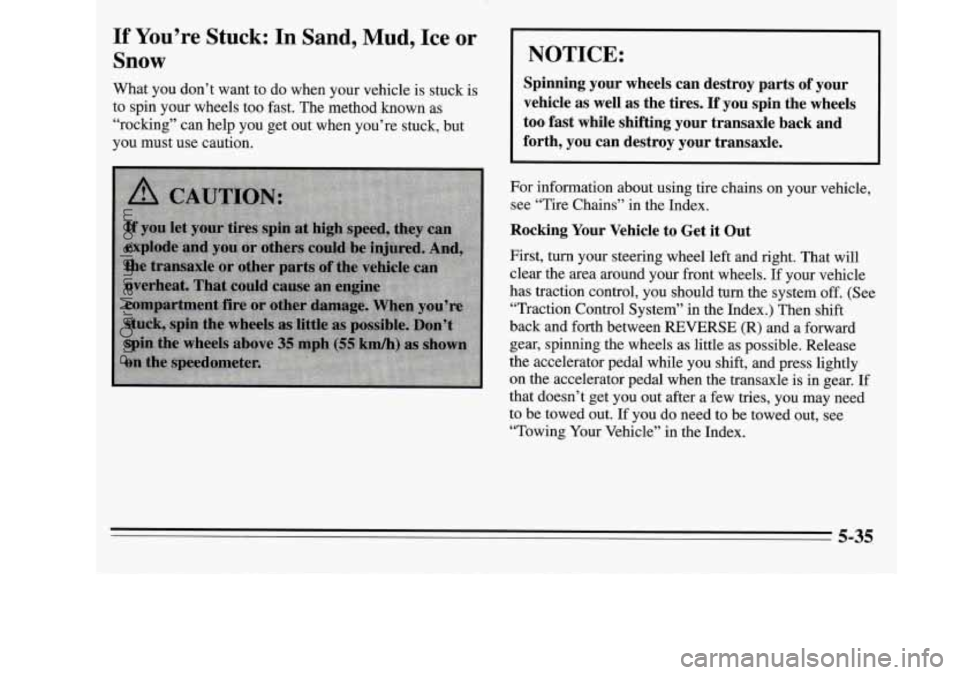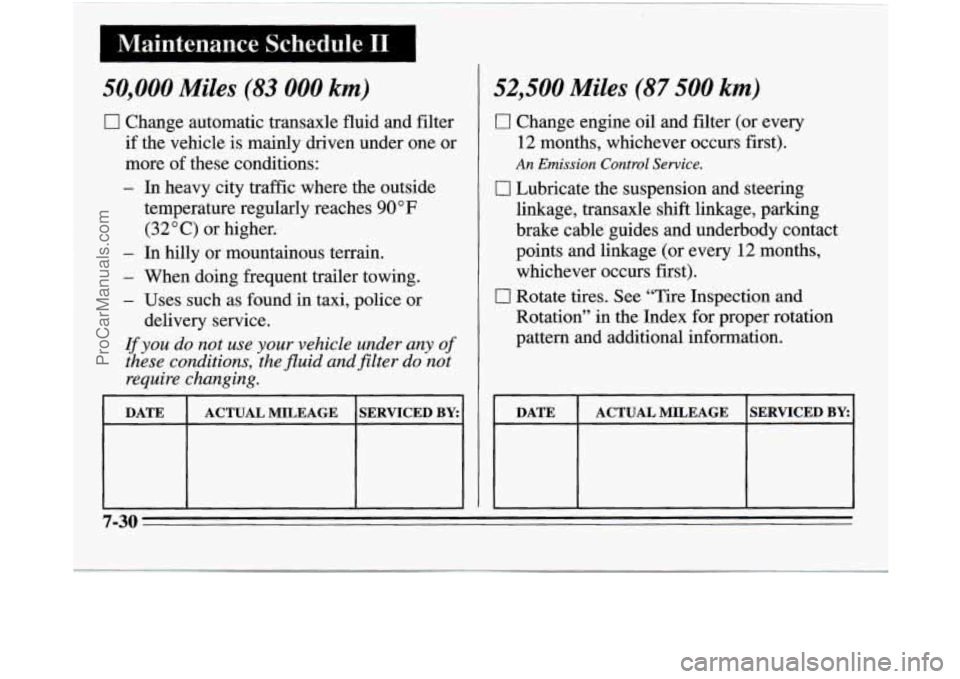Page 232 of 390
When your vehicle is being towed, have the key in the
ignition
in the OFF position. The steering wheel should
be clamped in a straight-ahead position, with a clamping
device designed for towing service.
Do not use the
vehicle’s steering column lock for this. The transaxle
should be in
NEUTRAL (N) and the parking brake
released.
Don’t have your vehicle towed on the front wheels,
unless you must.
If the vehicle must be towed on the
front wheels, don’t go more than
35 mph (56 km/h) or
farther than 50 miles (80 km) or your transaxle will be
damaged. If these limits must be exceeded, then the
front wheels have to be supported on a dolly.
5-10
ProCarManuals.com
Page 233 of 390
Towing from the Front -- Vehicle Hookup
Before hooking up to a tow truck, be sure to read all the
information
on “Towing Your Vehicle” earlier in this
section.
I NOTICE:
Do not tow with sling-type equipment or fascia
damage will occur. Use wheel-lift or car carrier
equipment. Additional ramping may be required
for car carrier equipment. Use safety chains and
wheel straps.
NOTICE:
Towing a vehicle over rough surfaces could
damage
a vehicle. Damage can occur from vehicle
to ground or vehicle to wheel-lift equipment. To
help avoid damage, install
a towing dolly and
raise vehicle until adequate clearance is obtained
between the ground and/or wheel-lift equipment.
Do not attach winch cables or J-hooks to
suspension components when using car carrier
equipment.
Always use T-hooks inserted in the
T-hook slots.
5-11
ProCarManuals.com
Page 235 of 390
Towing from the Rear -- Vehicle Hookup
Before hooking up to a tow truck, be sure to read all the
information on “Towing Your Vehicle” earlier in this
section.
1. Attach T-hook chains on both sides, in the slotted
holes in the frame rails, just ahead
of the rear wheels.
2. Position the lower sling crossbar directly under the
rear bumper.
No 4x4 wood beam is needed.
5-13
ProCarManuals.com
Page 236 of 390
4. Be certain your vehicle is towed no faster than
35 mph (56 km/h) and no farther than 50 miles
(80 km) to avoid damage to your transaxle.
NOTICE:
Towing a vehicle over rough surfaces could
damage a vehicle. Damage can occur from vehicle
to ground or vehicle to wheel-lift equipment. To
help avoid damage, install a towing dolly and
raise the vehicle until adequate clearance is
obtained between the ground and/or wheel-lift
equipment. Always use T-hooks inserted in the
T-hook slots. Never use J-hooks. They will
damage drivetrain and suspension components.
3. Attach a separate safety chain around the end of each
axle inboard
of the spring.
5-14
ProCarManuals.com
Page 257 of 390

If You’re Stuck: In Sand, Mud, Ice or
Snow
What you don’t want to do when your vehicle is stuck is
to spin your wheels too fast. The method known as
“rocking” can help you get out when you’re stuck, but
you must use caution.
NOTICE:
Spinning your wheels can destroy parts of your
vehicle as well as the tires.
If you spin the wheels
too fast while shifting your transaxle back and
forth, you can destroy your transaxle.
For information about using tire chains on your vehicle,
see “Tire Chains’’ in the Index.
Rocking Your Vehicle to Get it Out
First, turn your steering wheel left and right. That will
clear the area around your front wheels.
I€ your vehicle
has traction control, you should turn the system off. (See
“Traction Control System” in the Index.) Then shift
back and forth between
REVERSE (R) and a forward
gear, spinning the wheels as little as possible. Release
the accelerator pedal while you shift, and press lightly
on the accelerator pedal when the transaxle is in gear. If
that doesn’t get you out after a few tries, you may need
to be towed out.
If you do need to be towed out, see
“Towing Your Vehicle” in the Index.
ProCarManuals.com
Page 337 of 390
I Maintenance Schedule I I
50,000 Miles (83 000 km)
0 Change automatic transaxle fluid and filter
if the vehicle is mainly driven under one or
more of these conditions:
- In heavy city traffic where the outside
temperature regularly reaches
90 OF
(32 O C) or higher.
- In hilly or mountainous terrain.
- When doing frequent trailer towing.
- Uses such as found in taxi, police or
If you do not use your vehicle under any of
these conditions, the fluid andfilter do not
require changing.
delivery service.
I DATE ( ACTUAL MILEAGE ISERVICED BY:(
51,000 Miles (85 000 km)
0 Change engine oil and filter (or every
3 months, whichever occurs first).
An Emission Control Service.
DATE
SERVICED BY: ACTUAL MILEAGE
7-15
ProCarManuals.com
Page 347 of 390
I Maintenance Schedule I I
100,000 Miles (166 000 km)
0 Change automatic transaxle fluid and filter
if the vehicle is mainly driven under one or
more
of these conditions:
- In heavy city traffic where the outside
temperature regularly reaches
90 O F
(32°C) or higher.
- In hilly or mountainous terrain.
- When doing frequent trailer towing.
- Uses such as found in taxi, police or
lfyou do not use your vehicle under any of
these conditions, the fluid and filter do not
require changing.
delivery service.
;
ACTUAL MILEAGE
SERVICED BY
7-25
ProCarManuals.com
Page 352 of 390

-
Maintenance Schedule I1
50,000 Miles (83 000 km)
0 Change automatic transaxle fluid and filter
if the vehicle is mainly driven under one or
more of these conditions:
- In heavy city traffic where the outside
temperature regularly reaches
90 O F
(32 O C) or higher.
- In hilly or mountainous terrain.
- When doing frequent trailer towing.
- Uses such as found in taxi, police or
lfyou do not use your vehicle under any of
these conditions, the fluid and filter do not
require changing.
delivery service.
L 1
1
52,500 Miles (87 500 km)
0 Change engine oil and filter (or every
12 months, whichever occurs first).
An Emission Control Service.
0 Lubricate the suspension and steering
linkage, transaxle shift linkage, parking
brake cable guides and underbody contact
points and linkage (or every
12 months,
whichever occurs first).
0 Rotate tires. See “Tire Inspection and
Rotation” in the Index for proper rotation
pattern and additional information.
rn
ACTUAL MILEAGE SERVICED BY:
7-30
ProCarManuals.com